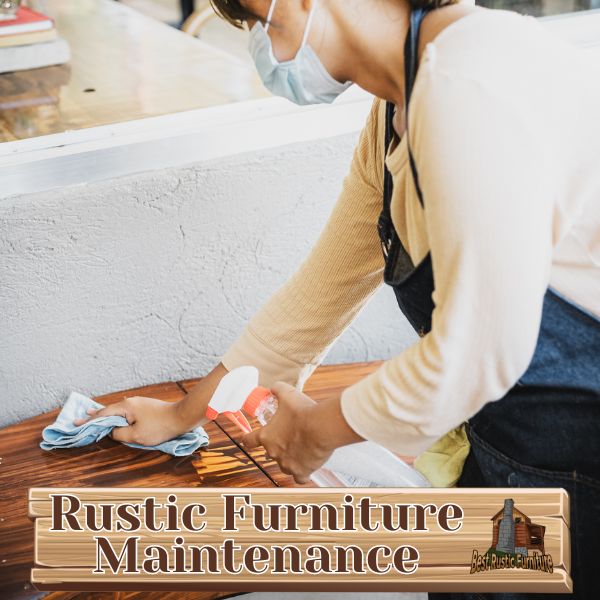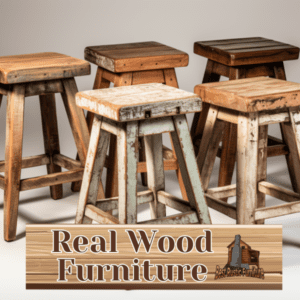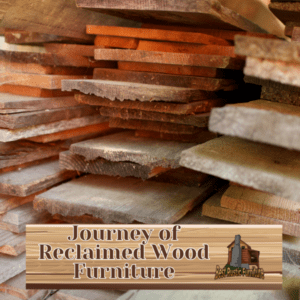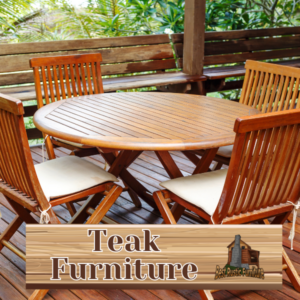
Ensuring the longevity of rustic furniture requires proper maintenance and care. Rustic furniture, known for its natural and timeless appeal, adds a unique charm to any space. To understand how to maintain rustic furniture effectively, it is essential to have a clear understanding of what it is and its characteristics.
Rustic furniture is characterized by its raw and organic aesthetic, incorporating elements such as natural wood, distressed finishes, and handcrafted details. It often evokes feelings of warmth, simplicity, and a connection to nature. Common types of rustic furniture include log furniture, reclaimed wood furniture, and farmhouse-style furniture.
Maintenance is crucial for rustic furniture for several reasons. Firstly, it helps preserve its aesthetic appeal, keeping it looking its best over time. Regular maintenance also prevents damage and wear, ensuring the longevity of the furniture and protecting your investment. Implementing best practices for rustic furniture maintenance is essential to ensure its longevity.
These practices include regular cleaning and dusting to remove dirt and debris, applying protective coatings to safeguard the furniture from moisture and stains, repairing and restoring any damages, and practicing proper placement and usage to minimize wear and tear. It is essential to be aware of common mistakes to avoid when maintaining rustic furniture, such as using harsh cleaning agents or neglecting regular maintenance. Following these best practices and avoiding common mistakes will contribute to the long-term preservation of your rustic furniture, allowing you to enjoy its beauty for years to come.
Key takeaway:
- Regular cleaning and dusting: To ensure the longevity of rustic furniture, it is essential to regularly clean and dust the pieces. This helps prevent the buildup of dirt and debris that can cause damage or wear over time.
- Applying protective coatings: Applying protective coatings, such as wax or varnish, can help protect rustic furniture from moisture, stains, and other damage. These coatings create a barrier that shields the wood and enhances its longevity.
- Proper placement and usage: Placing rustic furniture away from direct sunlight and extreme temperatures can prevent warping, cracking, or fading. Additionally, using furniture pads, coasters, and avoiding excessive weight can help maintain the integrity of the furniture.
Understanding Rustic Furniture
Rustic furniture has a unique charm that adds warmth and character to any space. In order to truly appreciate and care for these pieces, we must first understand the essence and features of rustic furniture. We will explore the definition and characteristics, as well as the different types of rustic furniture. From reclaimed wood to handcrafted details, get ready to delve into the world of rustic furniture and gain insights into its timeless allure.
Definition and Characteristics of Rustic Furniture
Rustic furniture is defined by its natural, unrefined appearance, showcasing the beauty of imperfections. The key characteristics of rustic furniture include its use of raw materials like wood, stone, and metal, as well as traditional craftsmanship techniques. Additionally, rustic furniture incorporates imperfections such as knots, cracks, and rough edges, which add to its unique charm and character.
These defined characteristics and qualities make rustic furniture a popular choice for individuals seeking a warm and inviting aesthetic in their homes or spaces. It is important to properly maintain rustic furniture to ensure its visual quality and durability for years to come.
Types of Rustic Furniture
Rustic furniture encompasses a variety of styles that add a charming and cozy touch to any space. When considering types of rustic furniture, you have several options to choose from. These include:
- Barnwood furniture: Made from reclaimed wood, barnwood furniture showcases the beauty and durability of old barns.
- Log furniture: Crafted from logs, log furniture highlights the natural textures and patterns of the wood.
- Twig furniture: With its intricate designs, twig furniture incorporates branches and twigs for a rustic and artistic look.
- Adirondack furniture: Inspired by mountain lodges, Adirondack furniture features wide arms, slanted backs, and a relaxed style.
Pro-tip: When selecting rustic furniture, it is important to choose pieces that align with your personal style and complement the overall aesthetic of your space.
Why is Maintenance important for Rustic Furniture?
Maintenance is key when it comes to ensuring the longevity of rustic furniture. Discover why taking care of your rustic furniture is crucial in preserving its aesthetic appeal and preventing damage and wear. Let’s dive into the importance of maintenance and explore the benefits it brings to the table.
Preservation of Aesthetics
Preservation of aesthetics is a vital aspect for maintaining the visual quality of rustic furniture. To achieve this, it is essential to consider the following best practices:
- Regular cleaning and dusting: It is important to use a microfiber cloth for gently removing dust and debris from the surface of the furniture.
- Applying protective coatings: To preserve the natural beauty of the wood and prevent staining, it is recommended to apply a suitable protective coating such as wax or oil.
- Repairing and restoring: Promptly address any scratches, dents, or other damages to maintain the overall appearance of the furniture.
- Proper placement and usage: To prevent warping, fading, and other damages, ensure that the furniture is kept away from direct sunlight, extreme temperatures, and damp areas.
- Using furniture covers: Whenever the furniture is not in use or during periods of extended storage, it is advisable to cover it with furniture covers. This will protect it from dust, moisture, and environmental elements.
By following these practices, you can ensure the longevity and visual appeal of your rustic furniture.
Prevention of Damage and Wear
Proper maintenance of rustic furniture is essential for preventing damage and wear. Here are some steps to follow for effective prevention:
- Regular cleaning and dusting to remove dirt and debris.
- Applying protective coatings like wax or polish to shield the furniture from scratches and moisture.
- Repairing and restoring any damages promptly to prevent further deterioration.
- Using appropriate placement and usage to avoid excessive weight or stress on the furniture.
By following these steps, you can ensure the prevention of damage and wear, promoting the longevity of your rustic furniture while avoiding any unnecessary damage or wear.
Best Practices for Rustic Furniture Maintenance
Discover the secret to maintaining the timeless beauty of rustic furniture with these expert best practices. From regular cleaning and dusting to applying protective coatings, repairing and restoring, and ensuring proper placement and usage, each sub-section in this guide will equip you with valuable tips and techniques to keep your rustic furniture looking its best. Say goodbye to wear and tear and hello to longevity as we delve into the world of rustic furniture maintenance.
Regular Cleaning and Dusting
- Start by regularly cleaning and dusting your rustic furniture to maintain its visual quality and longevity.
- Use a soft brush or a microfiber cloth to remove loose dust and dirt.
- Wipe down the surfaces with a gentle cleanser specifically formulated for wood furniture.
- Pay close attention to crevices and corners where dust tends to gather during regular cleaning and dusting sessions.
- Avoid using excessive water or harsh cleaning chemicals that can potentially damage the wood during the regular cleaning and dusting process.
- After dusting and cleaning, use a dry cloth to remove any excess moisture and prevent the wood from drying out.
- Consider applying furniture polish or wax to restore shine and provide additional protection during your regular cleaning and dusting routine.
- Make sure to repeat this cleaning and dusting routine at regular intervals, especially in high-traffic areas or if the furniture is exposed to environmental elements.
By incorporating regular cleaning and dusting into your furniture maintenance routine, you can ensure the beautiful appearance and long-lasting durability of your rustic furniture.
Applying Protective Coatings
“`
Applying protective coatings is an essential step in maintaining the longevity and visual quality of rustic furniture. Here are the steps to follow:
- Clean the surface of the furniture using a microfiber cloth to remove any dust or debris.
- Sand the surface lightly to smooth out any imperfections and create a better bonding surface for the protective coating.
- Choose the appropriate protective coating based on the type of rustic furniture and its needs. Options include varnish, polyurethane, or wax.
- Apply the protective coating evenly and in thin layers using a brush or a soft cloth. Follow the manufacturer’s instructions for drying and curing times.
- Allow the protective coating to dry completely before using or placing any objects on the furniture.
- Repeat the process of applying protective coatings periodically to maintain the furniture’s durability and appearance over time.
Rustic furniture has a long history dating back to ancient civilizations, where applying protective coatings was integral to preserving its beauty. Crafted using natural materials and techniques, rustic furniture symbolizes simplicity and timelessness, with its unique textures and imperfections cherished. The application of protective coatings becomes even more essential to ensure the longevity of these pieces for future generations to admire.
Repairing and Restoring
- Inspect the furniture: Assess the extent of damage, such as scratches, cracks, or loose joints.
- Prepare the surface: Clean the furniture thoroughly using a mild detergent and a soft cloth.
- Repairing the damage: Fill in any cracks or chips using wood filler, and sand the surface until smooth.
- Restoring the furniture: Apply a matching stain to restore the color, and seal it with a protective finish to enhance durability.
- Reassemble if needed: Ensure that all joints are secure and tighten any loose screws or bolts.
Pro-tip: Regular maintenance and prompt repair of any minor damages can prevent further deterioration and help your rustic furniture last for many years.
Proper Placement and Usage
Proper placement and usage are essential for maintaining the integrity and longevity of rustic furniture. Here are some essential guidelines to follow to ensure the proper placement and usage of rustic furniture:
- Avoid placing rustic furniture directly in sunlight or near heat sources to prevent fading or warping.
- Make sure to place the furniture on a stable and level surface to prevent wobbling and potential damage.
- Protect the surface of the furniture from spills, stains, and scratches by using coasters or placemats.
- Prevent damage to the legs or joints of the furniture by avoiding dragging or sliding it.
- To distribute wear and maintain their shape, regularly rotate cushions and pillows.
By following these guidelines for proper placement and usage, you will help preserve the visual quality and structural integrity of rustic furniture for years to come.
Common Mistakes to Avoid
When it comes to maintaining rustic furniture, avoiding common mistakes is crucial to ensure its longevity and beauty. Here are some common mistakes to avoid:
- Exposing furniture to direct sunlight: This can cause fading and warping.
- Using harsh cleaning products: Avoid common mistakes by not using products with chemicals that can strip away the furniture’s protective finish.
- Neglecting regular maintenance: To avoid common mistakes, make sure to regularly clean, polish, and apply protective coatings to keep the furniture in top condition.
- Placing furniture near heat sources: Excessive heat can dry out and crack the wood, so it’s important to avoid this common mistake.
Pro-tip: Invest in furniture covers to shield your rustic pieces from dust, moisture, and scratches. This will help extend their lifespan and preserve their natural appeal.
Tips for Long-Term Preservation of Rustic Furniture
Tips for Long-Term Preservation of Rustic Furniture
- Dust regularly using a soft cloth or brush to prevent buildup.
- Apply furniture wax or polish to protect the wood and enhance its natural beauty.
- Avoid placing furniture in direct sunlight or near heat sources to prevent drying and fading.
- Keep furniture away from humid areas to prevent warping or cracking.
- Use coasters or placemats to protect the furniture from spills and water damage.
A true story exemplifying the importance of these preservation tips involves a family who inherited a beautiful rustic dining table. By following these tips for long-term preservation of rustic furniture, they were able to maintain its charm and functionality for generations to come, creating cherished memories around the table.
Frequently Asked Questions
How can I protect my hardwood furniture from damage?
To protect your hardwood furniture from damage, you should:
- Maintain a stable temperature and humidity level in the room where the furniture is placed.
- Avoid sudden changes in climate, as they can cause the wood to crack.
- Use a humidifier in the winter and an air conditioner in the summer to maintain optimal humidity levels.
- Store the furniture in a dry, cool place to prevent cracking and warping.
- Keep the furniture away from heat sources like radiators, heat runs, or fireplaces.
- Regularly dust and clean the furniture to prevent scratches and damage.
- Use furniture covers, especially during low humidity months, to protect the hardwood furniture.
- Avoid placing heavy objects on the furniture to prevent warping or cracking.
What should I do to prevent my hardwood furniture from cracking?
To prevent cracking in your hardwood furniture:
- Maintain stable humidity levels in the room.
- Avoid sudden changes in humidity, as they can cause significant damage.
- Use a humidifier in the winter and an air conditioner in the summer to maintain optimal humidity levels.
- Store the furniture in a dry, cool place.
- Keep the furniture away from heat sources like radiators, heat runs, or fireplaces.
- Avoid placing heavy objects on the furniture to prevent warping or cracking.
How can I maintain optimal humidity levels for hardwood furniture?
To maintain optimal humidity levels for hardwood furniture:
- Use a humidifier in the winter to add moisture to the air.
- Use an air conditioner or dehumidifier in the summer to reduce moisture.
- Monitor and maintain a relative humidity of 50-55% in the room where the furniture is placed.
- Avoid frequent and sudden changes in humidity, as they can cause significant damage to the furniture.
What specific care tips should I follow for glass and metal surfaces on my furniture?
For glass surfaces:
- Clean with a glass cleaner or a mixture of vinegar and water.
- Use a lint-free cloth or old newspaper for a streak-free finish.
For metal surfaces:
- Dust regularly with a soft cloth.
- Use a metal cleaner for stubborn stains.
Is it necessary to clean deep clean my furniture? How often should I do it?
Deep cleaning your furniture is not necessary on a regular basis, but it can help restore its appearance and remove built-up dirt and grime. You should deep clean your furniture once or twice a year, depending on the level of dirt and use.
Follow the specific care instructions for the material of your furniture and use appropriate cleaners and tools to avoid any damage.
What are some expert tips for ensuring the longevity of rustic furniture?
Some expert tips for ensuring the longevity of rustic furniture include:
- Dust furniture regularly to prevent the buildup of airborne deposits.
- Protect furniture from sunlight by positioning it away from direct sunlight or using curtains and UV-protective tint on windows.
- Use furniture covers or throw blankets to prevent damage from kids and pets.
- Train children and pets not to jump on or scratch the furniture.
- Use appropriate cleaners and avoid harsh chemicals that can damage the furniture.
- Maintain stable temperature and humidity levels to prevent drying out or absorbing excess moisture.






